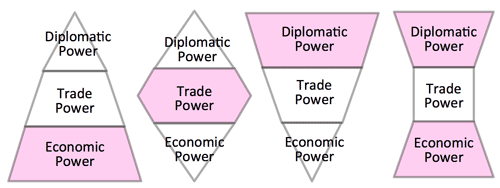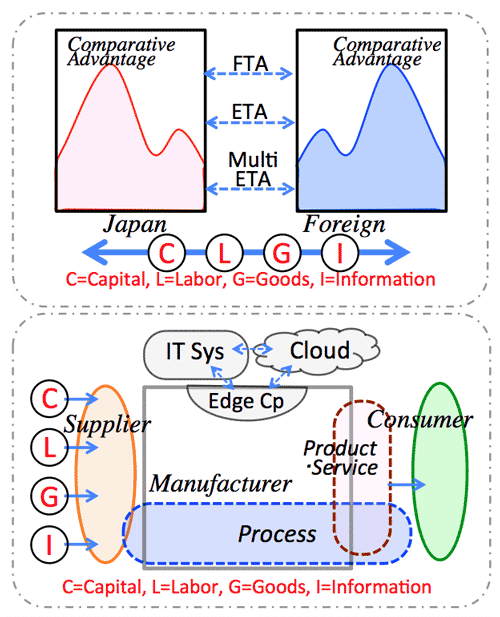>Top 1. Free trade and IoT are two tides:
- Tide of IoT:
- Since around 2016, as soon as German and US groups typically manufacturers proposed concrete concept of IoT (Internet of Things) as the industrial Internet, other advanced and emerging countries like China or India who are active IT users quickly responded to such movement considering possibility expansion of their involvement.
- Tide of Free Trade:
- >Top However, the flow towards Free Trade has long historical background; appeared as the counter concept against protectionism based on mercantilism in 19C. Thereafter WTO was established in 1994 after reorganization of GATT, aiming Free Trade system including not only goods, but also finance, information and services. This realized wide range of movements to pursue Free Trade system, with the result that bilateral or multilateral Free Trade Agreement (FTA), or Economic Trade Agreement (ETA) even including easing of human transfer and business restrictions. In 2016 Trans- Pacific Partners agreement (TPP) is expected to be almost established; but the multi-national consensus needs to get fresh start after the withdrawal of US.
- In June 2016, UK chose exit from EU ('Brixit') by its referendum, and in November 2016, D. Trump won at the presidential election defying most of expectations, who called for US first policy, withdrawal from TPP, and renegotiation of NAFTA. In 2017 E. Macron was elected as the president of France, but M. Le Pen of Front National requiring withdrawal from EU gained 34.9% vote at the final ballot. These trends show protectionism could become majority in various situations.
- However, in July 2017 it is reported that Japan and EU basically agreed at EPA negotiation including tariff reduction of automobile from Japan, and wine and cheese from EU. It seems that the centripetal force to Free Trade is so strong that economical matters get steady results rather than controversial political issues.
- Regarding to IoT movement, which attained to the stage being able to propose feasible model after 30 years development since 1980s. The two tides of Free Trade and IoT was recognized to have such a large impact. Japan as a trading nation should continue steady stance to Free Trade commitment in the middle and long-term perspective.
- Superposing effect of the two tides:
- Free Trade system and IoT closely affect to the economic structure of each country; such as 1) economic power (competitiveness of each industry), 2) trading power (international competitiveness), and 3) diplomatic power (stable mutually beneficial relations); each strength and leverage are different in the historical and geographical environment of each country concerned. (>Fig-1)
- Each country has its national strategy how to allocate its resources to each industrial sector for sustainable development of the economy and the society. Japan is required to establish what kind of economic relations with neighboring countries in addition to Japan-US and Japan-EU relationship; considering economic and social issues, including particular birthrate and aging population in such a changing market and environment.
- Significance of IoT:
- IoT could not be properly translated in Japanese, unlike Free Trade system. IoT is usually defined as "Machine-to-Machine Internet" or "Network of networks composed of recognizable edge devices which connect locally and globally without human intervention", which is hardly understood among the general public.
- >Top Around 2013 Germany published ambitious report of IoT compiled by collaboration of industry, academia, and government, proclaiming 'Industrie 4.0', after the first revolution of steam engine, the second of oil and electricity, and the third of computer.
- >Top In 2014, GE of US proposed 'Predix' as the standard interface of IoT, and then the cross-industrial organization named 'Industrial Internet Consortium (IIC) was established by more than 100 industries. In Japan, cross-industrial organization was established in 2015, which has not succeeded yet in making the similar impact like Germany or US.
- Japan had experienced high economic growth (more than 10% per annum) for 18 years (1955-73), succeeding to construct matured and stable society with rich middle class. But after collapse of the bubble economy in 1990, the economic disparity is getting apparent, causing further increase of late or unmarried people. Though younger generation are mostly digital-native and enthusiastic smart phone or tablet PC users, they will not tend to be engineers of the supplier side, to say nothing of builders of IoT system.
- Role of senior generation:
- >Top In high economic growth age, it was a dream of then youth to be involved in foreign business relationship, from inducing high-technology, developing and importing necessary materials, then making and exporting high-grade products; which provided talent personnels for Trade Japan. But since the Internet age, consciousness of Japanese youth became more domestic-oriented, not challenging to study abroad or become overseas staff for the company; that is 'Xenophobia youth is proliferating. From when Japan has become an psychologically isolated country? Free Trade system and IoT could be an revival of two big events just like an arrival of black warships at late Edo Period.
- Japan may overcome weaknesses at IoT system:
- Made in Japan products have high brand value. On the other it is often pointed out that Japanese products and corporations have following weaknesses: 1) Japanese products becomes too expensive and slow in delivery due to those over qualification or performance. 2) Design and service of the products are not responsive to global customers' needs. 3) Insufficient explanation or description of user manuals or other documentations, 4) Services of call center are Japanese only and no foreign language support, 5) Products are assumed to be used only in Japanese domestic. Troubles used in overseas are not basically supported.
- >Top On the other hand, advanced IT-related destructive technologies are progressing worldwide beyond national boundary; including IoT, AI, Big data, Block chain, etc. Particularly since 2017, AI applying deep learning methodology defeated the top professionals in Chess, Go, and Shogi one after another; it is said that AI might have exceeded the human ability (Singularity). Also self-driving cars by AI are under active development. Development of legal systems in IoT age are also urged to utilize such high-technology.
- These could be applicable in other industrial areas such as medical diagnosis, services for finance and insurance, estimate of energy consumption, research and education, construction, or even agriculture.
- Adverse wind against Free Trade system:
- Since 2016 UK and US adverse winds are blowing against Free Trade system. Japan have no choice but to take actions in realizing mutual benefits step by step by promoting Free Trade system in longer viewpoint; which could also contribute to the global community in stabilizing world economy and in promoting world peace.
- In the field of economy mutual penetration and dependance are getting to progress; it is impossible to stop the flow of Free Trade by constructing the national wall border. US and UK are front-runners in promoting 21 century industries such as aggressive finance information and media, high-tech ventures, intelligent services using influential power of English, etc.
- >Top US president Trump is sympathetic to the labors in the Rust belt zone since the presidential election, and committed to revive industries creating more jobs; it is doubtful to what extent these public commitments could be realized. It might be a cunning plan that US claims Japan, China and other emerging countries earn excessive trade surplus due to unfair trade practices; which make them recognize the value of surplus created by 20 century industries (expecting to be delayed in responding to IoT).
- Free Trade system and IoT have points in common:
- >Top In bilateral or multilateral FTA or ETA, any partners consider how to optimize mutual benefits by combining production factors of own and partner's industrial structure. These production factors are common in both of Free Trade system and IoT; i.e., Capital, Labor, Goods, and Information (CLGI).
- In IoT age, the factor of Information can enhance other factors; e.g., C×I is electronic money using Blockchain technology, L×I is ICT-enhanced expert or AI robots, G×I is product with many embedded sensors which could be supported through life cycle.
- More importantly, such production factors (CLGI) can evolve according to age, place and environment into new-investment, new-labor custom and relocation, new-product and services, and new-information and knowledge and combination of these. (>Fig-2)
- >Top From Free Trade agreement to IoT symbiosis:
- IoT is a new group of factories connected digital network between global partners, who are mostly selected from the partners of Free Trade agrement. Because the Free Trade partners were selected from mutual benefit, recognizing each strengthness and weakness. If it developed to IoT relationship, the partnership could be much mutually beneficial relationship through network (Symbiosis).
|
1. 【起】自由貿易とIoTは2つの波:
- IoTの波:
- 2016年頃より、IoT (Internet of Things)は、産業のインターネットとして、ドイツと米国の製造業が中心になって具体的な提言がなされるや否や、先進国のみならずIT活用を重視する中国・インドは、第4次産業革命へ新たな機能拡大を目指して素早く反応した。
- 自由貿易
- 一方、自由貿易への流れの背景は古く、19世紀の重商主義に基づく保護主義に対抗する概念として提唱されてきた。その後、GATTを経て、WTOとして国際機関が設立され (1995年)、モノに加えて金融・情報・サービスの自由貿易体制を目指す動きが本格化した。その成果として、二国間および多国間での、自由貿易協定 (FTA)、さらには経済連携協定(EPA)として人の移動やビジネスの諸制約の緩和を含め、広範囲な自由貿易体制を求める動きになった。2016年にはTPPの実現が期待されたが、米国のTPP離脱によって、それまでの多国間合意は仕切り直しとなった。
- なお、2016年6月に、英国は国民投票によってEU離脱を選択し、また同年11月には、TPPやNAFTAを批判し米国ファーストを掲げるトランプ氏が予想を裏切って大統領に当選した。その後、2017年フランス大統領選挙では、EU維持のマクロン氏が当選したが、EU離脱を掲げ仏ファーストを標榜する国民戦線のルペン氏が決戦投票で34.9%の得票を得たことなど、これからも保護主義的な動きが多数派を占める可能性があり得ることを示した。
- しかし、2017年7月に日本とEUとのEPA協定で、日本の自動車とEUのワイン・チーズなどの関税引き下げを含む大筋合意が報道された。それほど自由貿易への求心力は根強く、経済的な交渉は、政治的な議論よりも着実に結果を残しているように思える。
- IoTの動きについても、1980年代からようやく30年余りの進展を経て、実現可能なモデルが提案される段階になった。これら自由貿易とIoTの2潮流は、2016年にそのインパクトの大きさが改めて認識された。貿易立国日本としては、自由貿易へのコミットメントに信念を持って、中長期視点で続けてしていくしかない。
- 2つの波の重畳効果:
- 自由貿易体制とIoTとは、各国の経済構造と密接に影響する。特に、1) 経済力 (各産業の競争力)、2) 貿易力 (国際競争力と貿易比率)、3) 外交力 (安定的な互恵関係) が関わる。それぞれの強さと力点の置き方には、各国の歴史や地理的環境によって異なる。<Fig-1>

- 各国とも、国家戦略として、どの分野に資源を配分して、経済や社会の持続的発展につなげていくのかが課題である。日本の場合は、日米、日欧の関係に加えて、近隣諸国との経済関係をどう築いていくのか、また特に、市場や環境変化の中で、少子高齢化に伴う社会や経済の課題にいかに対処していくのかが問われている。
- IoTの意義:
- IoTは、自由貿易協定のような適訳がない。"モノのインターネット"と表現されたり、"人の介在なしにローカルまたはグローバルに接続する識別可能なエッジデバイスから成るネットワークのネットワーク"などと定義されるが、わかりにくく、一般に浸透しにくい原因ともなっている。
- IoTに関しては、2013年頃よりドイツでは産官学による意欲的な報告があり、1) 蒸気機関、2) 石油・電力、3) コンピュータ革命に続く"第4次産業革命"と位置づけられた。
- 米国では、2014年にGEがIoTのインターフェースとしてのPredix(注*1)を提案し、また産業界中心に100社以上が結集し、推進組織(IIC, Industrial Internet Consortium )を結成され、活発な活動が開始した。日本も官民でのIoT推進コンソーシアムが2015年に設立されたが、まだドイツや米国のような流れにはなっていない。
- 日本は、1955-73の18年間もの間、年10%超の高度成長を遂げ、充実した中流階層による安定的な社会を築いたが、1990年のバブル経済崩壊以降、経済格差拡大が顕在化し、相当数の若者が将来の展望を喪失し、さらに非婚化・少子化に拍車をかけている。デジタルネイティブと言われる若者はスマホの熱心なユーザーではあるが、その供給の側の技術者になろうとしないし、さらにIoTシステムの構築者となり得るのかは期待薄である。
- 年長世代の役割:
- 経済の高度成長時代、海外の先進技術を導入し、必要な原材料を開発輸入して高品質の製品を作り、輸出するなど海外ビジネスと関わることが当時の若者の夢であり、それが貿易日本を支える人材供給となってきた。だが、インターネット時代となって若者の意識はむしろ国内志向的となり、留学や海外駐在と関わることを避ける傾向もあり、即ち、海外嫌い(Xenophobia)が増殖中である。日本はいつから精神的な鎖国となってしまったのか。自由貿易体制とIoTとの2大インパクトは、幕末に来航した黒船に匹敵する事件とさえ思うのに。
- IoTシステムは日本の弱点を克服する良い機会:
- Made in Japan製品のブランド力は高い反面、日本製品および日本企業はしばしば、以下の弱点を指摘されている。曰く、1) 日本製品は過剰性能ゆえに価格が高過ぎて、納期遅い、2) 製品のデザインやそのサービスは、グローバルな消費者のニーズに対応していない、3) 製品マニュアルその他資料の説明や記述が不十分、 4) コールセンタのサービスが日本語のみで、外国語でのサービスがない、5) 日本国内での使用を前提にしている製品が多く、海外はサポート対象外が多いなど。
- 他方、新たなIT関連の破壊的な技術は国境に関係なく世界中で進行中である。IoT、 AI、ビッグデータ、ブロックチェーンなどである。2017年以降、囲碁や将棋の分野で、AIが次々とトッププロを破ったことで、AIの能力はすでに人間の能力を超えた (Singularity) かも知れないとの見解もある。
- またAIによる車の自動運転も、鋭意開発中である。これら先進技術の本格的普及には、IoT時代の整備が欠かせない。
- これらは、他の産業分野で応用可能である。例えば、医療診断、金融保険サービス、エネルギー消費予測、研究教育、建設や農業分野などである。
- 自由貿易体制への逆風:
- 昨年来の英・米の動向を見ると、世界の自由貿易体制に逆風が吹いている。日本としては、長期の視点で、自由貿易体制によって互恵を実現していること、さらに世界景気の安定や平和の維持にも貢献していることを国際社会に示し続けるしかない。
- 経済の面では、相互浸透・相互依存はさらに進展しており、もはや国家間に壁を築くことで自由貿易の流れは止められない。一方で米英は、金融や情報・メディア、ハイテクベンチャー、英語のもつ影響力を活かした知的産業など、21世紀型の産業を「着々と進展させている。
- 米国トランプ大統領は、選挙戦からRust beltの労働者に同情して、さらなる雇用を増やす産業の復権を公約しているが、どこまで実現可能かは疑問である。トランプ政権は、日本や中国の過剰な貿易黒字の原因は、不公平な取引慣行が原因と主張しているが、これは相手国にとって貿易黒字を稼ぎ出す20世紀型産業の価値 (それはIoTへの対応の遅延への期待)を過剰に強調する奇策かも知れない。
- 自由貿易体制とIoTとの共通点:
- 二国間または多国間のFTAやETA協定の締結に当たっては、自国および相手国の産業構造の生産要素をどう組合せれば互恵関係が最適化するかをまず検討する。経済基盤要素としては、自由貿易体制もIoT時代も共通している。ここでは、生産要素をカネ(Capital)・ヒト(Labor)・モノ(Goods)・情報(Information)というビジネス創出のCLGI (クロジ)順で考える。(Fig-2)

- またIoT時代には、Iの要素が他の要素をEnhanceする。C×IではBlockchain活用による電子マネーが出現し、L×Iは、情報武装化したエキスパートやいずれはAIロボットが登場する。G×Iは、センサーを埋め込んだ製品によってライフサイクルでのサポート面で威力を発揮する。
- さらに重要な点としては、CLGIの生産要素が、時代・環境に合わせて進化することである。新資本構成、新採用・新配転、新製品サービス、新情報・新知識とこれらの組合せである。
- 自由貿易での連携からIoTでの共生へ進化する:
- IoTは、グローバルなデジタルネットワークで接続された国際連携による新たな工場群システムである。その連携相手は、自由貿易協定の相手からまず選ばれる。そもそも相互補完の関係で選んだ相手の強み弱みはよく認識した上で互恵の最適化を求めて選んだ相手であるからである。それがIoTの仕組みに発展すれば、その連携はネットワークを通じた永続的な共生関係となる。
|

